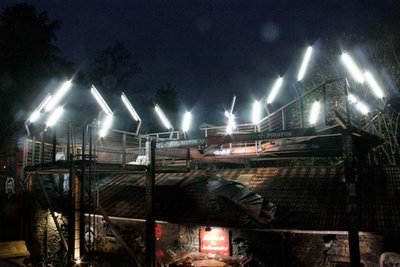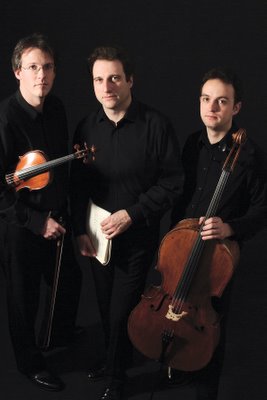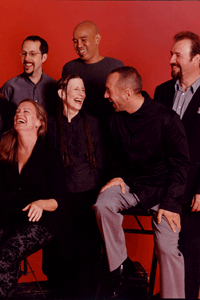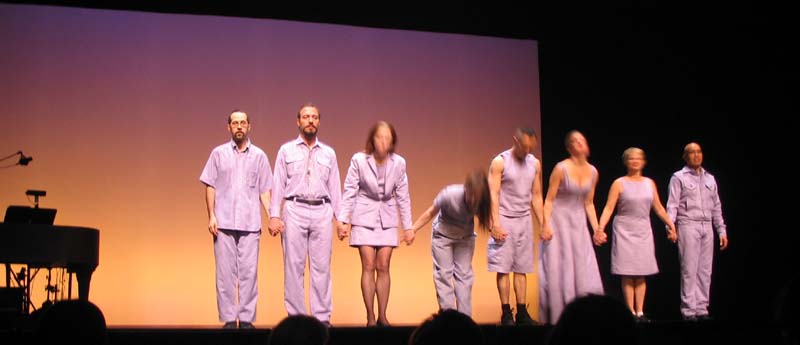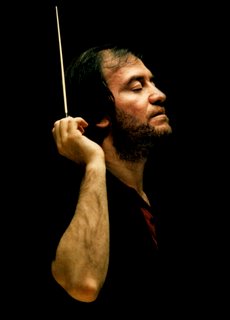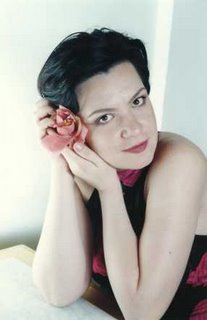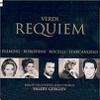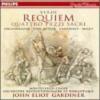Last month | Next monthClassical Month in Washington is a monthly feature that appears on the first of the month. If there are concerts you would like to see included on our schedule, send your suggestions by e-mail (ionarts at gmail dot com). Happy listening!Wednesday, March 1, 7:30 pm; March 2 and 3, 7:30 pm; March 4 and 5, 1:30 and 7:30 pm
New York City Ballet (various programs)
Kennedy Center Opera House
See the
review by Sarah Kaufman (
Washington Post, March 3)
Thursday, March 2, 8 pm
Baltimore Symphony:
Khatchatryan’s Award-Winning SibeliusWith violinist Sergey Khatchatryan and guest conductor Andrew Constantine (replacing Yuri Temirkanov, unable to return from Russia for personal reasons)
Music Center at Strathmore
[On
March 3 and 4, 8 pm, and March 5, 3 pm, at Meyerhoff Hall in Baltimore]
See the
review by Jens F. Laurson (Ionarts, March 3)
Friday, March 3, 8 pm
Ensemble Corund (Stephen Smith, Artistic Director)
A cappella choral music on Shakespeare texts
Library of CongressSee the
review by Cecelia Porter (
Washington Post, March 6)
Friday, March 3, 8 pm
Parker String QuartetTower, Quartet "Nightfields"; Schumann, Quartet in A Minor; Mozart, C Major Quintet, K. 515 (with Roger Tapping, viola)
Corcoran Gallery of Art
See the
review by Jens F. Laurson (Ionarts, March 5)
Friday, March 3, 8 pm; Saturday, March 4, 8 pm
Matthias Soucek, piano
Embassy SeriesEmbassy of Austria
See the
review by Jens F. Laurson (Ionarts, March 8)
Friday, March 3, 8 pm; Sunday, March 5, 2 pm
Mozart, Così Fan TutteDirected by Joe Banno
Opera Theatre of Northern Virginia
Thomas Jefferson Community Theatre (Alexandria, Va.)
See the
review by Charles T. Downey (Ionarts, March 4)
Friday, March 3, 8 pm; Saturday, March 4, 5 and 8 pm; Sunday, March 5, 2 pm
Folger Consort: Hildegard and JaufreFolger Shakespeare Library
Saturday, March 4, 1:30 pm
Gounod, Roméo et JulietteWith Natalie Dessay and Ramón Vargas
Metropolitan Opera Radio BroadcastSaturday, March 4, 8 pm
Leslie Savoy Burrs,
VanquiOpera in concert version
Clarice Smith Performing Arts Center (College Park, Md.)
See the
review by Karren L. Alenier (Ionarts, March 9)
Sunday, March 5, 3 pm
Spiritus!: A Choral Celebration of the Spirit, with baritone Steven Combs
Music by Vaughan Williams, Tallis, Rutter, Finzi, and David McCullough
Free subscriber-only concert
National Presbyterian Church
Sunday, March 5, 5 pm
Alan Mandel, piano [FREE, with admission to museum]
Phillips CollectionSee the
review by Joan Reinthaler (
Washington Post, March 8)
Tuesday, March 7, 12:10 pm
Noontime Cantata:
Nimm von uns, Herr, du treuer Gott, BWV 101
Washington Bach Consort
Church of the Epiphany (13th and G Streets NW)
Tuesday, March 7, 12:15 pm
The Garden of Earthly Delights: Music of early centuries on historical harps [FREE]
Constance Whiteside, harp
St. George’s Episcopal Church (915 N. Oakland Street, Arlington, Va.)
Tuesday, March 7, 7:30 pm
Musicians from Marlboro II [FREE]
Beethoven's Piano and Woodwind Quintet, op. 16; Nielsen's Woodwind Quintet, op. 43; Eliot Carter's Eight Etudes and a Fantasy; and songs by Schubert from his op. 129, D. 965
Freer Gallery of ArtSee the
review by Jens F. Laurson (Ionarts, March 11)
Wednesday, March 8, 7 and 9 pm
Turtle Island String QuartetThe Mansion at Strathmore
See the
review by Charles T. Downey (Ionarts, March 10)
Wednesday, March 8, 7:30 pm
American Piano: Copland, the Piano and Politics, with various artists [FREE]
American Piano FestivalClarice Smith Performing Arts Center (College Park, Md.)
See the
review by T. L. Ponick (
Washington Times, March 11)
Wednesday, March 8, 7:30 pm
Sharon Isbin, guitar, with Susanne Mentzer, mezzo-sopranoFortas Chamber Music Series
Kennedy Center Terrace Theater
Thursday, March 9, 7:30 pm
American Piano: Charles Ives and the American Pianist [FREE]
Lecture on and performance of Ives's
Concord Sonata (Steven Mayer)
American Piano FestivalClarice Smith Performing Arts Center (College Park, Md.)
Friday, March 10, 8 pm
Ian Bostridge, tenor, Julius Drake, piano, and the Belcea Quartet
Fauré, "La bonne chanson," op. 61; Shostakovich, String Quartet no. 3 in F Major, op. 73; Vaughan Williams,
On Wenlock EdgeLibrary of CongressSee the
review by Charles T. Downey (Ionarts, March 13)
Friday, March 10, 8 pm
Russian National OrchestraStravinsky’s arrangement of Tchaikovsky’s Excerpts from Sleeping Beauty, Stravinsky’s La baiser de la fée (“The Fairy's Kiss”), and Tchaikovsky’s Suite No. 3 for Orchestra in G Major, Op. 55
George Mason University Center for the Arts (Fairfax, Va.)
See the
review by Mark J. Estren (
Washington Post, March 13)
Friday, March 10, 8 pm
Peter Sirotin (violin), Claudia Chudacoff (violin), Michael Stepniak (viola), Julius Wirth (viola), Fiona Thompson (cello)
Mozart String Quintets I
Embassy SeriesEmbassy of Austria
Friday, March 10, 8 pm
St. Lawrence String QuartetDiscovery Series
Barns at Wolf Trap
See the
review by Tom Huizenga (
Washington Post, March 13)
Friday, March 10, 8 pm; Saturday, March 11, 8 pm; Saturday, March 12, 8 pm
Biava Quartet
Dumbarton Oaks (Friends of Music)Saturday, March 11, 1:30 pm
Verdi,
La Forza del DestinoWith Deborah Voigt, Ildikó Komlósi, Salvatore Licitra, Juan Pons, and Samuel Ramey
Metropolitan Opera Radio BroadcastSaturday, March 11, 4:30 pm
Boston Symphony Orchestra (with
James Levine David Robertson)
Lorraine Hunt Lieberson sings
Neruda SongsKennedy Center Concert Hall (WPAS)
See the
review by Jens F. Laurson (Ionarts, March 12)
Saturday, March 11, 8 pm
Baltimore Symphony:
Strauss's Ein Heldenleben and Prokofiev's second violin concertoWith Sayaka Shoji, violin
Music Center at Strathmore
[Also on
March 9 and 10, 8 pm, and March 12, 3 pm, at Meyerhoff Hall in Baltimore]
See the
review by Jens F. Laurson (Ionarts, March 16)
Saturday, March 11, 8 pm
JCC Symphony Orchestra, with violinist Nicolas Kendall
Music includes Sibelius violin concerto and
Finlandia, and excerpts from Smetana's
Má VlastJewish Community Center of Greater Washington (Rockville, Md.)
Saturday, March 11, 8:15 pm; Wednesday, March 15, 7:30 pm; Friday, March 17, 8:15 pm; Sunday, March 19, 3 pm
Jake Heggie,
Dead Man WalkingBaltimore Opera
See the
review by Charles T. Downey (Ionarts, March 14)
Sunday, March 12, 3 pm
Left Bank Quartet, with pianists Larissa Dedova, Bradford Gowen, and Rita Sloan [NOT FREE]
Foote, Piano Trio in B-flat Major (1907-08); Ives: Violin Sonata No. 2 (1907-10); and Amy Beach, Piano Quintet in F-sharp Minor (1908)
American Piano FestivalClarice Smith Performing Arts Center (College Park, Md.)
Sunday, March 12, 5 pm
Lina Bahn, violin [FREE, with admission to museum]
Phillips CollectionSunday, March 12, 7:30 pm
New York Festival of Song (VAS)
Marie Lenormand (mezzo-soprano) and Hugh Russell (baritone)
Steven Blier, pianist
Kennedy Center Terrace Theater
See the
review by Stephen Brookes (
Washington Post, March 14)
Sunday, March 11, 7:30 pm
Nicolas Kendall, violin
Music by Mozart, Ravel, Saint-Saëns, Kreisler, and Sarasate
Jewish Community Center of Greater Washington (Rockville, Md.)
Tuesday, March 14, 7:30 pm
Dora Seres, fluteYoung Concert Artists Series
Kennedy Center Terrace Theater
See the
review by Jens F. Laurson (Ionarts, March 19)
Tuesday, March 14, 7:30 pm (pre-concert lecture by Dr. Peter Casarella, 6:30 pm)
Manuel de Falla and the Music of Faith (music by Victoria, Soler, and de Falla)
Post-Classical Ensemble, with soprano Rosa Lamoreaux [FREE]
Virginia Theological Seminary, Lettie Pate Auditorium (3737 Seminary Road, Alexandria, Va.)
Thursday, March 16, 7 pm; Friday, March 17, 8 pm; Saturday, March 18, 8 pm
National Symphony Orchestra with Garrick Ohlsson, pianoKennedy Center Concert Hall
[
Free performance by members of the NSO, Saturday, March 18, 6 pm, Millennium Stage]
See the
review by Daniel Ginsberg (
Washington Post, March 17)
Thursday, March 16, 8 pm; Friday, March 17, 8 pm
Baltimore Symphony Orchestra with Emanuel Ax, pianoYardumian's
Armenian Suite, Mozart's
Piano Concerto No. 9, and Stravinsky's
PetrouchkaJoseph Meyerhoff Symphony Hall (Baltimore, Md.)
[Same program, without the Yardumian piece, as a
Casual Concert on Saturday, March 18, 11 am]
See the
review by Jens F. Laurson (Ionarts, March 17)
Thursday, March 16, to Sunday, March 19
Mozart,
Così Fan TutteDirected by Cindy Oxberry, conducted by Kate Tamarkin
Hartke Theatre
Catholic University of America
Friday, March 17, 8 pm
Mezzo-sopranos Margaret Lattimore, Stephanie Novacek, and Mary Phillips, with flutist Eugenia Zukerman [FREE]
Song cycles of Ricky Ian Gordon and Jake Heggie (also songs by Bernstein and Sondheim)
Library of CongressSaturday, March 18, 1:30 pm
Tchaikovsky,
MazeppaWith Olga Guryakova and Larissa Diadkova, conducted by Valery Gergiev
Metropolitan Opera Radio BroadcastSaturday, March 18, 2 pm
Roberto Cominati, pianoKennedy Center Terrace Theater (WPAS)
See the
review by Jens F. Laurson (Ionarts, March 21)
Saturday, March 18, 8 pm
Francis Poulenc Trio
Embassy SeriesEmbassy of the Republic of Poland
See the
review by Jens F. Laurson (Ionarts, March 24)
Saturday, March 18, 8 pm
National Philharmonic: Famous Opera ChorusesMusic Center at Strathmore
Saturday, March 18, 8 pm
Fairfax Symphony Orchestra, with cellist Zuill Bailey
George Mason University Center for the Arts (Fairfax, Va.)
Sunday, March 19, 2 pm
Kennedy Center Chamber PlayersMusic by Beethoven and Mozart
Kennedy Center Terrace Theater
See the
review by Tim Page (
Washington Post, March 21)
Sunday, March 19, 3 pm
Chamber music and jazz by Washington composers, with Holly Bass, poet
Washington Musica VivaAtlas Performing Arts Center (1333 H Street NE)
Sunday, March 19, 5 pm
Michael Sheppard, piano [FREE, with admission to museum]
Phillips CollectionSunday, March 19, 5:30 pm
Jordi Savall with Hesperion XXI
The Paul and Barbara Krieger Early Music Concert
Shriver Hall, Johns Hopkins (Baltimore, Md.)
Sunday, March 19, 6:30 pm
Egidius Kwartet [FREE]
17th-century Dutch music for vocal quartet
National Gallery of ArtTuesday, March 21, 8 pm
Washington Bach Consort and Cathedral Choral SocietyMusic of Bach, plus Orff's [yawn]
Carmina BuranaKennedy Center Concert Hall
See the
review by Jens F. Laurson (Ionarts, March 25)
Wednesday, March 22, 7:30 pm
Sara Daneshpour, piano [FREE]
National Museum of Women in the Arts (for reservation, call 202-783-7370 or e-mail reservations@nmwa.org)
Thursday, March 23, 7 pm; Friday, March 24, 1:30 pm; Saturday, March 25, 8 pm
National Symphony Orchestra with Emanuel Ax, pianoKennedy Center Concert Hall
See the
review by Robert R. Reilly (Ionarts, March 24)
Thursday, March 23, 7:30 pm
Pedja Muzijevic (Broadwood piano) and Tanya Tompkins (cello)Music by Hummel, Schumann, and Chopin
The Mansion at Strathmore
Thursday, March 23, 8 pm
Baltimore Symphony: Mozart's Birthday CelebrationAll-Mozart program, with pianist Christian Blackshaw
Music Center at Strathmore
[Also on
March 24 and 25, 8 pm, and March 26, 3 pm, at Meyerhoff Hall in Baltimore]
See the
review by Tim Smith (
Baltimore Sun, March 25)
Friday, March 24, 8 pm
Bach Collegium Japan (Maasaki Suzuki, Artistic Director) [FREE]
All-Bach program
Library of CongressSee the
review by Jens F. Laurson (Ionarts, March 28)
Friday, March 24, 8 pm
Peter Sirotin (violin), Claudia Chudacoff (violin), Michael Stepniak (viola), Julius Wirth (viola), Fiona Thompson (cello)
Mozart String Quintets II
Embassy SeriesEmbassy of Austria
See the
review by Andrew Lindemann Malone (
Washington Post, March 27)
Saturday, March 25, 1:30 pm
Verdi,
Luisa MillerWith Barbara Frittoli, Neil Shicoff, and James Morris
Metropolitan Opera Radio BroadcastSaturday, March 25, 7 pm; Thursday, March 30, 7:30 pm; Sunday, April 2, 2 pm (four more performances through April 14)
Wagner,
Das RheingoldWashington National Opera
Saturday, March 25, 8 pm
National Philharmonic: Brahms, German RequiemWith baritone William Sharp and soprano Linda Mabbs
Music Center at Strathmore
Saturday, March 25, 8:30 pm; Sunday, March 26, 7:30 pm
Alisa Weilerstein, cello
Jewish Community Center of Greater Washington (Rockville, Md.)
Sunday, March 26, 6:30 pm
Rachel Barton Pine, violin, and Matthew Hagle, piano
Music by Biber, Corigliano, Mozart, and Schumann
National Gallery of ArtSee the
review by Charles T. Downey and Jens F. Laurson (Ionarts, March 28)
Monday, March 27, 8 pm
London Philharmonic Orchestra (Kurt Masur, music director)
Kennedy Center Concert Hall
See the
review by Jens F. Laurson (Ionarts, March 30)
Wednesday, March 29, 8 pm
Murray Perahia,
Peter Serkin, pianoMusic Center at Strathmore (WPAS)
See the
review by George A. Pieler (Ionarts, March 31)
Thursday, March 30, 6 and 7 pm
Sound artists Richard Chartier and Taylor Deupree
World premiere of a new musical work,
Specification Fifteen, created especially for the Hiroshi Sugimoto exhibition
Lerner Room
Hirshhorn Museum and Sculpture GardenSee the
review by Charles T. Downey (Ionarts, March 31)
Friday, March 31, 7:30 pm
Vadim Repin, violin, and Nikolai Lugansky, pianoJoseph Meyerhoff Symphony Hall (Baltimore, Md.)
Friday, March 31, 8 pm
Takács QuartetMozart, String Quartet No. 19 in C Major, K. 465 “Dissonance”; Bartók, String Quartet No. 2, Op. 17; Schubert, String Quartet No. 14 in D Minor, D. 810 “Death and the Maiden”
Corcoran Gallery of Art
Friday, March 31, 8 pm
Judith Bettina (soprano), Robert Taub (piano), Curtis Macomber (violin) [FREE]
Chamber Music of Milton Babbitt
Library of CongressFriday, March 31, 8 pm
Baltimore Symphony: What Dreams Are Made OfSibelius, Swan of Tuonela; Stravinsky, The Firebird; Michael Daugherty, Hell's Angels
Symphony with a Twist Series
Music Center at Strathmore
Friday, March 31, 8 pm; Saturday, April 1, 5 and 8 pm; Sunday, April 2, 2 pm
Folger Consort: Landini and Machaut, with Trefoil
Folger Shakespeare Library
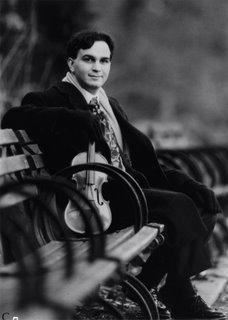 Gil Shaham was very much the Primus inter pares amid the Academy of St. Martin in the Fields during their performances of Anton Arensky’s Variations on a Theme of Tchaikovsky, op. 50, and the Tchaikovsky Souvenir de Florence, op. 70, at Strathmore last Sunday. The group performed beautifully, compact and like a well-oiled machine. If there was a touch of routine beneath the surface of beauty in the Arenksy, it was outshone by the sheer professionalism of these two dozen players. And not only was the Academy in good form in their WPAS-presented concert, the very fact that Arenksy – a much underrated composer – made it onto the program was a delight. Marvelously Romantic and original, even when he riffs off Tchaikovsky as in his Variations, which he first culled from a Tchaikovsky song (“Legends”), for his string quartet where it served as the second movement. It went over just as well as the concluding echt-Tchaikovsky. The Souvenir is a lush show-off piece for string ensembles, and the Academy and Shaham knew how to milk it to its maximum effect without going overboard. No wonder they elicited enthusiastic cheers and a Mozart encore.
Gil Shaham was very much the Primus inter pares amid the Academy of St. Martin in the Fields during their performances of Anton Arensky’s Variations on a Theme of Tchaikovsky, op. 50, and the Tchaikovsky Souvenir de Florence, op. 70, at Strathmore last Sunday. The group performed beautifully, compact and like a well-oiled machine. If there was a touch of routine beneath the surface of beauty in the Arenksy, it was outshone by the sheer professionalism of these two dozen players. And not only was the Academy in good form in their WPAS-presented concert, the very fact that Arenksy – a much underrated composer – made it onto the program was a delight. Marvelously Romantic and original, even when he riffs off Tchaikovsky as in his Variations, which he first culled from a Tchaikovsky song (“Legends”), for his string quartet where it served as the second movement. It went over just as well as the concluding echt-Tchaikovsky. The Souvenir is a lush show-off piece for string ensembles, and the Academy and Shaham knew how to milk it to its maximum effect without going overboard. No wonder they elicited enthusiastic cheers and a Mozart encore.




